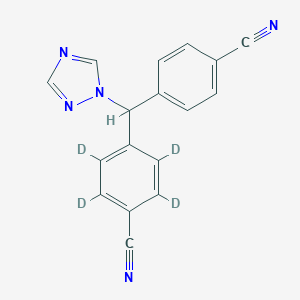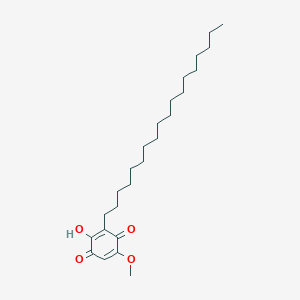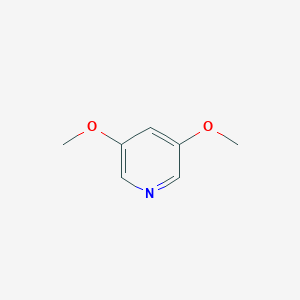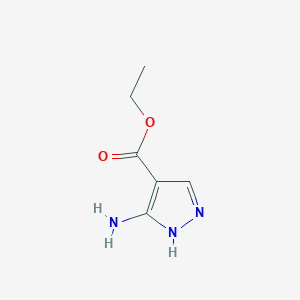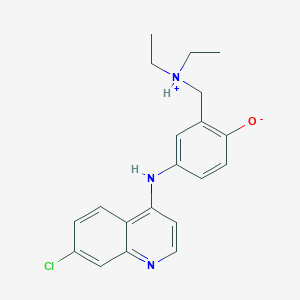
Amodiaquine
Overview
Description
Amodiaquine is a synthetic compound belonging to the class of 4-aminoquinolines. It is primarily used as an antimalarial drug, effective against Plasmodium falciparum malaria, especially in regions where resistance to other antimalarial drugs like chloroquine has developed . This compound is often used in combination with artesunate to enhance its efficacy and reduce the risk of resistance .
Mechanism of Action
Target of Action
Amodiaquine is an antimalarial drug that primarily targets the Fe (II)-protoporphyrin IX in the malaria parasite, Plasmodium falciparum . This compound plays a crucial role in the parasite’s survival and growth, making it an effective target for antimalarial drugs.
Mode of Action
Like other quinoline derivatives, it is thought to inhibit heme polymerase activity . This results in the accumulation of free heme, which is toxic to the parasites . This compound binds to the free heme, preventing the parasite from converting it into a less toxic form . This drug-heme complex is toxic and disrupts membrane function .
Biochemical Pathways
This compound affects the heme detoxification pathway in the malaria parasite. By inhibiting heme polymerase activity, it prevents the conversion of toxic free heme into a non-toxic form . This leads to the accumulation of toxic heme within the parasite, disrupting its normal functions and ultimately leading to its death .
Pharmacokinetics
This compound is quickly absorbed and converted into its main active form, desethylthis compound . The median this compound Tmax value is 0.91 h . This compound is eliminated principally through biotransformation with only around 2% excreted unchanged in urine . Its elimination half-life is 24–28 hours .
Result of Action
The action of this compound results in significant cytotoxicity in the malaria parasite, leading to its death . In addition to its antimalarial effects, this compound also has anti-inflammatory properties . It has been shown to depress cardiac muscle, impair cardiac conductivity, and produce vasodilatation with resultant hypotension . They also depress respiration and can cause diplopia, dizziness, and nausea .
Action Environment
The efficacy of this compound can be influenced by various environmental factors. For instance, the drug’s effectiveness can vary depending on the patient’s age and weight . This compound exposure was found to be significantly higher in infants and children aged 1–5 years compared to older children and adults, even though infants received a lower mg/kg this compound dose . This suggests that age and weight can influence the drug’s absorption and metabolism, potentially affecting its efficacy .
Biochemical Analysis
Biochemical Properties
Amodiaquine interacts with various biomolecules in its role as an antimalarial agent. The mechanism of plasmodicidal action of this compound is not completely certain. Like other quinoline derivatives, it is thought to inhibit heme polymerase activity . This results in the accumulation of free heme, which is toxic to the parasites. This compound binds the free heme, preventing the parasite from converting it to a form less toxic . This drug-heme complex is toxic and disrupts membrane function .
Cellular Effects
This compound has significant effects on various types of cells and cellular processes. It is known to depress cardiac muscle, impair cardiac conductivity, and produce vasodilatation with resultant hypotension . It also depresses respiration and can cause diplopia, dizziness, and nausea .
Molecular Mechanism
The molecular mechanism of action of this compound involves its interaction with free heme. This compound is thought to inhibit heme polymerase activity, leading to the accumulation of free heme . The drug then binds the free heme, preventing the parasite from converting it to a less toxic form . This drug-heme complex is toxic and disrupts membrane function .
Temporal Effects in Laboratory Settings
This compound has shown consistent effects over time in laboratory settings. A study of the pharmacokinetic properties of this compound provided evidence of high cure rates with exposure to the drug being remarkably consistent across all age groups .
Dosage Effects in Animal Models
While specific studies on the dosage effects of this compound in animal models are limited, it is known that the cardiovascular effects of this compound have been recognized from the earliest studies in animal models .
Metabolic Pathways
This compound is bioactivated hepatically to its primary metabolite, N-desethylthis compound, by the cytochrome p450 enzyme CYP2C8 . This metabolite is largely responsible for the antimalarial effect of the drug .
Transport and Distribution
This compound is likely to be widely distributed into body tissues, particularly in the liver, spleen, kidney, lungs, brain, and spinal cord .
Subcellular Localization
The subcellular localization of this compound is not well characterized. Given its mechanism of action, it is likely that this compound and its active metabolite are localized in the cytoplasm where they can interact with free heme .
Preparation Methods
Synthetic Routes and Reaction Conditions
Amodiaquine is synthesized through a multi-step process involving the reaction of 4,7-dichloroquinoline with 4-aminophenol in the presence of a base. The reaction proceeds through nucleophilic aromatic substitution, resulting in the formation of the intermediate compound, which is then further reacted with diethylamine to yield this compound .
Industrial Production Methods
Industrial production of this compound involves large-scale synthesis using similar reaction conditions as in the laboratory synthesis. The process is optimized for high yield and purity, with stringent quality control measures to ensure the final product meets pharmaceutical standards .
Chemical Reactions Analysis
Types of Reactions
Amodiaquine undergoes various chemical reactions, including:
Oxidation: This compound can be oxidized to form its primary metabolite, N-desethylthis compound.
Reduction: Reduction reactions are less common but can occur under specific conditions.
Substitution: Nucleophilic substitution reactions are involved in its synthesis and modification.
Common Reagents and Conditions
Oxidation: Common oxidizing agents include hydrogen peroxide and potassium permanganate.
Reduction: Reducing agents like sodium borohydride can be used.
Substitution: Bases such as sodium hydroxide are used in nucleophilic substitution reactions.
Major Products Formed
The major product formed from the oxidation of this compound is N-desethylthis compound, which retains antimalarial activity .
Scientific Research Applications
Amodiaquine has a wide range of scientific research applications:
Comparison with Similar Compounds
Amodiaquine is similar to other 4-aminoquinoline compounds such as chloroquine, mefloquine, and piperaquine . it has unique properties that make it effective against chloroquine-resistant strains of Plasmodium falciparum . Unlike chloroquine, this compound is often used in combination therapies to enhance its efficacy and reduce resistance .
List of Similar Compounds
- Chloroquine
- Mefloquine
- Piperaquine
- Lumefantrine
- Primaquine
- Tafenoquine
Properties
IUPAC Name |
4-[(7-chloroquinolin-4-yl)amino]-2-(diethylaminomethyl)phenol | |
|---|---|---|
| Source | PubChem | |
| URL | https://pubchem.ncbi.nlm.nih.gov | |
| Description | Data deposited in or computed by PubChem | |
InChI |
InChI=1S/C20H22ClN3O/c1-3-24(4-2)13-14-11-16(6-8-20(14)25)23-18-9-10-22-19-12-15(21)5-7-17(18)19/h5-12,25H,3-4,13H2,1-2H3,(H,22,23) | |
| Source | PubChem | |
| URL | https://pubchem.ncbi.nlm.nih.gov | |
| Description | Data deposited in or computed by PubChem | |
InChI Key |
OVCDSSHSILBFBN-UHFFFAOYSA-N | |
| Source | PubChem | |
| URL | https://pubchem.ncbi.nlm.nih.gov | |
| Description | Data deposited in or computed by PubChem | |
Canonical SMILES |
CCN(CC)CC1=C(C=CC(=C1)NC2=C3C=CC(=CC3=NC=C2)Cl)O | |
| Source | PubChem | |
| URL | https://pubchem.ncbi.nlm.nih.gov | |
| Description | Data deposited in or computed by PubChem | |
Molecular Formula |
C20H22ClN3O | |
| Source | PubChem | |
| URL | https://pubchem.ncbi.nlm.nih.gov | |
| Description | Data deposited in or computed by PubChem | |
DSSTOX Substance ID |
DTXSID2022597 | |
| Record name | Amodiaquine | |
| Source | EPA DSSTox | |
| URL | https://comptox.epa.gov/dashboard/DTXSID2022597 | |
| Description | DSSTox provides a high quality public chemistry resource for supporting improved predictive toxicology. | |
Molecular Weight |
355.9 g/mol | |
| Source | PubChem | |
| URL | https://pubchem.ncbi.nlm.nih.gov | |
| Description | Data deposited in or computed by PubChem | |
Physical Description |
Solid | |
| Record name | Amodiaquine | |
| Source | Human Metabolome Database (HMDB) | |
| URL | http://www.hmdb.ca/metabolites/HMDB0014751 | |
| Description | The Human Metabolome Database (HMDB) is a freely available electronic database containing detailed information about small molecule metabolites found in the human body. | |
| Explanation | HMDB is offered to the public as a freely available resource. Use and re-distribution of the data, in whole or in part, for commercial purposes requires explicit permission of the authors and explicit acknowledgment of the source material (HMDB) and the original publication (see the HMDB citing page). We ask that users who download significant portions of the database cite the HMDB paper in any resulting publications. | |
Solubility |
24.9 [ug/mL] (The mean of the results at pH 7.4), 8.80e-03 g/L | |
| Record name | SID50085969 | |
| Source | Burnham Center for Chemical Genomics | |
| URL | https://pubchem.ncbi.nlm.nih.gov/bioassay/1996#section=Data-Table | |
| Description | Aqueous solubility in buffer at pH 7.4 | |
| Record name | Amodiaquine | |
| Source | Human Metabolome Database (HMDB) | |
| URL | http://www.hmdb.ca/metabolites/HMDB0014751 | |
| Description | The Human Metabolome Database (HMDB) is a freely available electronic database containing detailed information about small molecule metabolites found in the human body. | |
| Explanation | HMDB is offered to the public as a freely available resource. Use and re-distribution of the data, in whole or in part, for commercial purposes requires explicit permission of the authors and explicit acknowledgment of the source material (HMDB) and the original publication (see the HMDB citing page). We ask that users who download significant portions of the database cite the HMDB paper in any resulting publications. | |
Mechanism of Action |
The mechanism of plasmodicidal action of amodiaquine is not completely certain. Like other quinoline derivatives, it is thought to inhibit heme polymerase activity. This results in accumulation of free heme, which is toxic to the parasites. The drug binds the free heme preventing the parasite from converting it to a form less toxic. This drug-heme complex is toxic and disrupts membrane function., Amodiaquine is a Mannich base 4-aminoquinoline with a mode of action similar to that of chloroquine. It is effective against some chloroquine-resistant strains of P. falciparum, although there is cross-resistance., The 4-aminoquinoline derivatives appear to bind to nucleoproteins and interfere with protein synthesis in susceptible organisms; the drugs intercalate readily into double-stranded DNA and inhibit both DNA and RNA polymerase. In addition, the drugs apparently concentrate in parasite digestive vacuoles, increase the pH of the vacuoles, and interfere with the parasite's ability to metabolize and utilize erythrocyte hemoglobin. Plasmodial forms that do not have digestive vacuoles and do not utilize hemoglobin, such as exoerythrocytic forms, are not affected by /these medications/., The 4-aminoquinoline derivatives ... have anti-inflammatory activity; however, the mechanism(s) of action of the drugs in the treatment of rheumatoid arthritis and lupus erythematosus has not been determined. /4-aminoquinoline derivatives/ reportedly antagonizes histamine in vitro, has antiserotonin effects, and inhibits prostaglandin effects in mammalian cells presumably by inhibiting conversion of arachidonic acid to prostaglandin F2., The mode of action of amodiaquine has not yet been determined. 4-Aminoquinolines depress cardiac muscle, impair cardiac conductivity, and produce vasodilatation with resultant hypotension; they depress respiration and cause diplopia, dizziness and nausea. | |
| Record name | Amodiaquine | |
| Source | DrugBank | |
| URL | https://www.drugbank.ca/drugs/DB00613 | |
| Description | The DrugBank database is a unique bioinformatics and cheminformatics resource that combines detailed drug (i.e. chemical, pharmacological and pharmaceutical) data with comprehensive drug target (i.e. sequence, structure, and pathway) information. | |
| Explanation | Creative Common's Attribution-NonCommercial 4.0 International License (http://creativecommons.org/licenses/by-nc/4.0/legalcode) | |
| Record name | AMODIAQUINE | |
| Source | Hazardous Substances Data Bank (HSDB) | |
| URL | https://pubchem.ncbi.nlm.nih.gov/source/hsdb/7457 | |
| Description | The Hazardous Substances Data Bank (HSDB) is a toxicology database that focuses on the toxicology of potentially hazardous chemicals. It provides information on human exposure, industrial hygiene, emergency handling procedures, environmental fate, regulatory requirements, nanomaterials, and related areas. The information in HSDB has been assessed by a Scientific Review Panel. | |
Color/Form |
Crystals from absolute ethanol | |
CAS No. |
86-42-0 | |
| Record name | Amodiaquine | |
| Source | CAS Common Chemistry | |
| URL | https://commonchemistry.cas.org/detail?cas_rn=86-42-0 | |
| Description | CAS Common Chemistry is an open community resource for accessing chemical information. Nearly 500,000 chemical substances from CAS REGISTRY cover areas of community interest, including common and frequently regulated chemicals, and those relevant to high school and undergraduate chemistry classes. This chemical information, curated by our expert scientists, is provided in alignment with our mission as a division of the American Chemical Society. | |
| Explanation | The data from CAS Common Chemistry is provided under a CC-BY-NC 4.0 license, unless otherwise stated. | |
| Record name | Amodiaquine [USP:INN:BAN] | |
| Source | ChemIDplus | |
| URL | https://pubchem.ncbi.nlm.nih.gov/substance/?source=chemidplus&sourceid=0000086420 | |
| Description | ChemIDplus is a free, web search system that provides access to the structure and nomenclature authority files used for the identification of chemical substances cited in National Library of Medicine (NLM) databases, including the TOXNET system. | |
| Record name | Amodiaquine | |
| Source | DrugBank | |
| URL | https://www.drugbank.ca/drugs/DB00613 | |
| Description | The DrugBank database is a unique bioinformatics and cheminformatics resource that combines detailed drug (i.e. chemical, pharmacological and pharmaceutical) data with comprehensive drug target (i.e. sequence, structure, and pathway) information. | |
| Explanation | Creative Common's Attribution-NonCommercial 4.0 International License (http://creativecommons.org/licenses/by-nc/4.0/legalcode) | |
| Record name | amodiaquine | |
| Source | DTP/NCI | |
| URL | https://dtp.cancer.gov/dtpstandard/servlet/dwindex?searchtype=NSC&outputformat=html&searchlist=13453 | |
| Description | The NCI Development Therapeutics Program (DTP) provides services and resources to the academic and private-sector research communities worldwide to facilitate the discovery and development of new cancer therapeutic agents. | |
| Explanation | Unless otherwise indicated, all text within NCI products is free of copyright and may be reused without our permission. Credit the National Cancer Institute as the source. | |
| Record name | Amodiaquine | |
| Source | EPA DSSTox | |
| URL | https://comptox.epa.gov/dashboard/DTXSID2022597 | |
| Description | DSSTox provides a high quality public chemistry resource for supporting improved predictive toxicology. | |
| Record name | Amodiaquine | |
| Source | European Chemicals Agency (ECHA) | |
| URL | https://echa.europa.eu/substance-information/-/substanceinfo/100.001.518 | |
| Description | The European Chemicals Agency (ECHA) is an agency of the European Union which is the driving force among regulatory authorities in implementing the EU's groundbreaking chemicals legislation for the benefit of human health and the environment as well as for innovation and competitiveness. | |
| Explanation | Use of the information, documents and data from the ECHA website is subject to the terms and conditions of this Legal Notice, and subject to other binding limitations provided for under applicable law, the information, documents and data made available on the ECHA website may be reproduced, distributed and/or used, totally or in part, for non-commercial purposes provided that ECHA is acknowledged as the source: "Source: European Chemicals Agency, http://echa.europa.eu/". Such acknowledgement must be included in each copy of the material. ECHA permits and encourages organisations and individuals to create links to the ECHA website under the following cumulative conditions: Links can only be made to webpages that provide a link to the Legal Notice page. | |
| Record name | AMODIAQUINE | |
| Source | FDA Global Substance Registration System (GSRS) | |
| URL | https://gsrs.ncats.nih.gov/ginas/app/beta/substances/220236ED28 | |
| Description | The FDA Global Substance Registration System (GSRS) enables the efficient and accurate exchange of information on what substances are in regulated products. Instead of relying on names, which vary across regulatory domains, countries, and regions, the GSRS knowledge base makes it possible for substances to be defined by standardized, scientific descriptions. | |
| Explanation | Unless otherwise noted, the contents of the FDA website (www.fda.gov), both text and graphics, are not copyrighted. They are in the public domain and may be republished, reprinted and otherwise used freely by anyone without the need to obtain permission from FDA. Credit to the U.S. Food and Drug Administration as the source is appreciated but not required. | |
| Record name | AMODIAQUINE | |
| Source | Hazardous Substances Data Bank (HSDB) | |
| URL | https://pubchem.ncbi.nlm.nih.gov/source/hsdb/7457 | |
| Description | The Hazardous Substances Data Bank (HSDB) is a toxicology database that focuses on the toxicology of potentially hazardous chemicals. It provides information on human exposure, industrial hygiene, emergency handling procedures, environmental fate, regulatory requirements, nanomaterials, and related areas. The information in HSDB has been assessed by a Scientific Review Panel. | |
| Record name | Amodiaquine | |
| Source | Human Metabolome Database (HMDB) | |
| URL | http://www.hmdb.ca/metabolites/HMDB0014751 | |
| Description | The Human Metabolome Database (HMDB) is a freely available electronic database containing detailed information about small molecule metabolites found in the human body. | |
| Explanation | HMDB is offered to the public as a freely available resource. Use and re-distribution of the data, in whole or in part, for commercial purposes requires explicit permission of the authors and explicit acknowledgment of the source material (HMDB) and the original publication (see the HMDB citing page). We ask that users who download significant portions of the database cite the HMDB paper in any resulting publications. | |
Melting Point |
206-208, 208 °C (decomposes), Yellow crystals from methanol. Melting point 243 °C. Slightly soluble in water and alcohol /Amodiaquine dihydrochloride hemihydrate/, 208 °C | |
| Record name | Amodiaquine | |
| Source | DrugBank | |
| URL | https://www.drugbank.ca/drugs/DB00613 | |
| Description | The DrugBank database is a unique bioinformatics and cheminformatics resource that combines detailed drug (i.e. chemical, pharmacological and pharmaceutical) data with comprehensive drug target (i.e. sequence, structure, and pathway) information. | |
| Explanation | Creative Common's Attribution-NonCommercial 4.0 International License (http://creativecommons.org/licenses/by-nc/4.0/legalcode) | |
| Record name | AMODIAQUINE | |
| Source | Hazardous Substances Data Bank (HSDB) | |
| URL | https://pubchem.ncbi.nlm.nih.gov/source/hsdb/7457 | |
| Description | The Hazardous Substances Data Bank (HSDB) is a toxicology database that focuses on the toxicology of potentially hazardous chemicals. It provides information on human exposure, industrial hygiene, emergency handling procedures, environmental fate, regulatory requirements, nanomaterials, and related areas. The information in HSDB has been assessed by a Scientific Review Panel. | |
| Record name | Amodiaquine | |
| Source | Human Metabolome Database (HMDB) | |
| URL | http://www.hmdb.ca/metabolites/HMDB0014751 | |
| Description | The Human Metabolome Database (HMDB) is a freely available electronic database containing detailed information about small molecule metabolites found in the human body. | |
| Explanation | HMDB is offered to the public as a freely available resource. Use and re-distribution of the data, in whole or in part, for commercial purposes requires explicit permission of the authors and explicit acknowledgment of the source material (HMDB) and the original publication (see the HMDB citing page). We ask that users who download significant portions of the database cite the HMDB paper in any resulting publications. | |
Retrosynthesis Analysis
AI-Powered Synthesis Planning: Our tool employs the Template_relevance Pistachio, Template_relevance Bkms_metabolic, Template_relevance Pistachio_ringbreaker, Template_relevance Reaxys, Template_relevance Reaxys_biocatalysis model, leveraging a vast database of chemical reactions to predict feasible synthetic routes.
One-Step Synthesis Focus: Specifically designed for one-step synthesis, it provides concise and direct routes for your target compounds, streamlining the synthesis process.
Accurate Predictions: Utilizing the extensive PISTACHIO, BKMS_METABOLIC, PISTACHIO_RINGBREAKER, REAXYS, REAXYS_BIOCATALYSIS database, our tool offers high-accuracy predictions, reflecting the latest in chemical research and data.
Strategy Settings
| Precursor scoring | Relevance Heuristic |
|---|---|
| Min. plausibility | 0.01 |
| Model | Template_relevance |
| Template Set | Pistachio/Bkms_metabolic/Pistachio_ringbreaker/Reaxys/Reaxys_biocatalysis |
| Top-N result to add to graph | 6 |
Feasible Synthetic Routes
Disclaimer and Information on In-Vitro Research Products
Please be aware that all articles and product information presented on BenchChem are intended solely for informational purposes. The products available for purchase on BenchChem are specifically designed for in-vitro studies, which are conducted outside of living organisms. In-vitro studies, derived from the Latin term "in glass," involve experiments performed in controlled laboratory settings using cells or tissues. It is important to note that these products are not categorized as medicines or drugs, and they have not received approval from the FDA for the prevention, treatment, or cure of any medical condition, ailment, or disease. We must emphasize that any form of bodily introduction of these products into humans or animals is strictly prohibited by law. It is essential to adhere to these guidelines to ensure compliance with legal and ethical standards in research and experimentation.


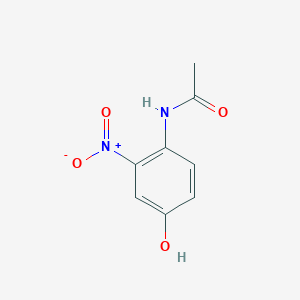



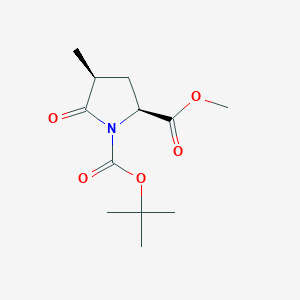
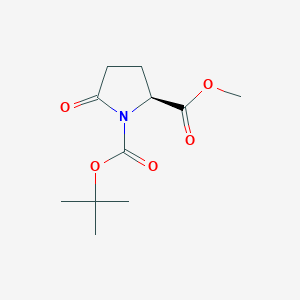
![Bicyclo[4.1.0]heptane-7-carboxamide, (1alpha,6alpha,7alpha)-(9CI)](/img/structure/B18291.png)

